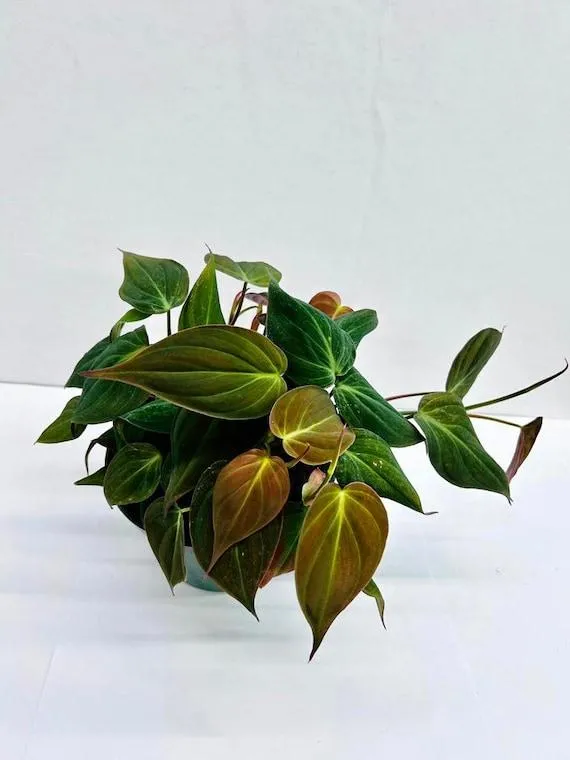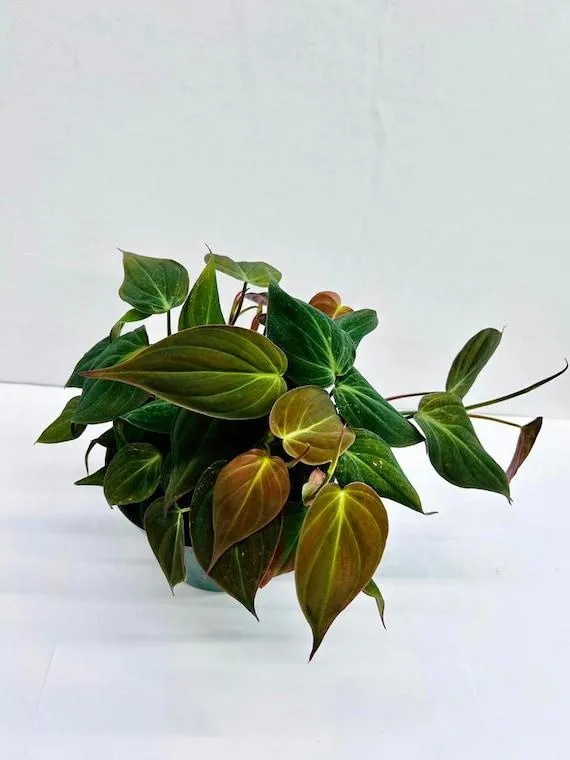Everything You Need to Know About the Velvety Philodendron
If you’ve done any research on low-maintenance houseplants, the velvety or velvet-leaf philodendron (Philodendron hederaceum) has likely come up. With its beautiful heart-shaped leaves and easy care requirements, it’s no wonder this plant is such a popular choice. In this article, I’ll cover all the basics on velvety philodendrons as well as answer some frequently asked questions.
Identification
- Leaves: Heart or arrowhead shaped with a velvety texture. Young leaves are often darker green and more rounded.
- Vines: Can climb or trail depending on support. Will trail without a structure to climb.
- Flowers: Small, inconspicuous white flowers occasionally form.
The velvety texture is what gives this philodendron its common name. Unlike some other philodendrons with shiny leaves, the velvety leaves feel soft or fuzzy to the touch.
Care Requirements
Velvety philodendrons are celebrated for their low-maintenance nature. From my experience keeping many of these plants, here are the basics for care:
Water: Allow the top inch or two of soil to dry out between waterings. During the growing season, water whenever the top soil feels dry. Cut back to monthly watering over winter when growth is slower.
Light: Thrives in medium to low light conditions like indirect sunlight. Will tolerate low light for prolonged periods if needed. Avoid direct sun which can burn the leaves.
Soil: Well-draining potting mix is ideal. Choose a soil blend with lots of organic material to retain moisture without getting soggy.
Humidity: Prefers humid conditions around 50% or higher but is adaptable and will grow in average home humidity levels.
Fertilizer: Feed monthly in the growing season with a dilute liquid houseplant fertilizer.

No matter your cares or skills, the velvety philodendron is fairly difficult to kill and bounces back well from neglect. This resilience is a hallmark of its easy care personality.
Propagation
Philodendrons are rampant growers and propagating new plants from cuttings or by division is straightforward. Here are a few propagation methods to try:
- Take 4-6 inch stem cuttings with a node, remove lower leaves, and place in water. Roots will form within 2-4 weeks.
- Take rooted cuttings or pull off plantlets from the mother plant and pot up in soil. These will transplant easily.
- Divide the root ball of mature plants in spring every 2-3 years to refresh and make multiples.
With even minimal effort, velvety philodendrons will reward you with abundant new plants. I find propagation hugely satisfying and also an excellent way to share the plant joy.
Pests and Problems
Like most houseplants, the velvety philodendron is generally very low maintenance but can develop occasional issues. Some potential problems and solutions:
Spider mites: Tiny spider-like pests that cause leaf stippling. Isolate and spray leaves with water to dislodge. Neem oil or insecticidal soap also help control infestations.
Mealybugs: Fluffy white insects that secrete honeydew. Wipe leaves with cotton balls dipped in rubbing alcohol. May need repeated applications.
Overwatering: Can cause yellow leaves and root rot. Improve drainage, check for soggy soil, and scale back water until improving.
Underwatering: Leaves will wrinkle, fold, and brown at the tips. Resume regular watering and increase as new growth appears.

With a watchful eye and prompt treatment, pests and problems can generally be managed without severe effects on this flexible philodendron.
Pruning
Pruning is not strictly necessary for velvety philodendrons but can be done to shape, control size, or remove damaged sections. Here are some tips:
- Use clean, sharp scissors or pruning shears sterilized with rubbing alcohol.
- Prune above a node, just under a leaf joint, to encourage branching and fullness.
- Trim off any browned or unsightly sections as desired for aesthetics.
- No need to seal cuts or apply wound dressings on robust plants like this philodendron variety.
With judicious pruning, you can keep velvety philodendrons looking their best for many years. More severe pruning may also be done for rejuvenation or to start overgrown specimens anew.
FAQs
Here are answers to some frequently asked questions:
Is the velvety philodendron toxic to pets? Yes, like many houseplants, all parts can cause mild to severe gastrointestinal upset if ingested by dogs or cats. Keep out of reach.
Will it climb or trail? Both! It will climb any surface or structure but also trail gracefully without support. Give it a moss pole or cage for optimum vertical growth.
How big will it get? Mature specimens can reach 8-10 feet tall if given vertical space. Most remain smaller, 3-6 feet, when potted or trailing.
Does it flower? Occasionally! Small white blooms may form but the plant is grown primarily for its lush foliage rather than conspicuous flowers.

Any cultivars? Yes, there are a few named forms including ‘Brazil’, with darker leaves, compact ‘N’Joy’ patented for larger leaf size, and variegated ‘Golden)’.
I hope this covers all the essentials on caring for and growing velvety philodendron! Feel free to ask if any other questions come up. These plants are truly one of the best for bringing beauty and greenery to any home.
Velvety Philodendron Care Guide
| Plant Part | Description |
|---|---|
| Leaves | Heart-shaped, velvety texture, green with occasional light green variegation |
| Growth | Vigorous vine grower, can climb or trail, grows 3-6 inches per year |
| Water | Keep soil lightly moist, allow top inch to dry between waterings |
| Light | Bright indirect light, protect from direct sun which can scorch leaves |
| Temperature | Household temperatures 65-80°F, can tolerate lower temperatures for short periods |
| Soil | Well-draining potting mix, likes humidity so group with other plants |
| Propagation | Take stem cuttings in spring, root in water or potting mix |
FAQ
-
What type of plant is a velvety philodendron?
The velvety philodendron is a kind of indoor hanging plant that has deep green leaves with a velvety texture. It’s a vine-like plant that can grow pretty long, sometimes reaching the floor!
-
What conditions does a velvety philodendron like?
Velvety philodendrons prefer bright, indirect sunlight. They do not take well to direct sun. The soil should be well-draining potting mix. They need moderate water and don’t want soggy soil. High humidity is awesome for them, though they can put up with normal indoor conditions too. Temperatures around 65°F to 85°F are basically perfect.
-
How do you care for a velvety philodendron?
Water whenever the top inch or two of soil is dry. You can water from above or bottom water – either way works. Mist the leaves to boost humidity. Feed monthly in the growing season with a diluted liquid houseplant food. Prune off any dead or dying stems. Repot only when the roots start circling the drainage holes, using a pot just one size larger.
-
Why are velvety philodendron leaves velvety?
The leaves have a dense covering of tiny hairs that give them a super soft texture, almost like velvet. Scientists are not totally sure of the purpose of these hairs, but some theories are that they help reduce water loss through transpiration or offer some protection from insects. The leaves sure are gorgeous though, with them being so fuzzy and deep green!
-
Can velvety philodendron leaves be used for anything?
While the leaves are not usually edible for humans, some tribes in Philippines and Indonesia are reported to eat young philodendron leaves as a vegetable. The dense hairs on velvety philodendron leaves could perhaps be spun into thread or fiber. But usually these plants are just grown for their amazing foliage and used decoratively indoors.

-
What are some tips for propagating velvety philodendron?
It’s easy to propagate new velvety philodendron plants from cuttings. Simply take 6-8 inch stem cuttings, remove the bottom leaves, and place the stem in a jar of water. Within a few weeks, you should see roots starting to grow. When the roots are 2-3 inches long, pot them up in soil. Mist the soil frequently until the new plant is established. In no time, you’ll have yourself an army of velvety philodendrons!
-
Is there anything that can harm a velvety philodendron?
For the most part, velvety philodendrons are very low maintenance plants. However, they are not fond of direct sun or extreme temperature changes, which could cause leaf burn or drop. Pests like spider mites or mealybugs could be a problem too, if left untreated. Overwatering can lead to root rot as well. But with the right care, these gorgeous plants can last for years looking awesome.
